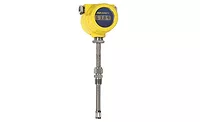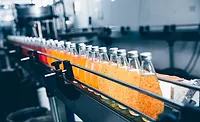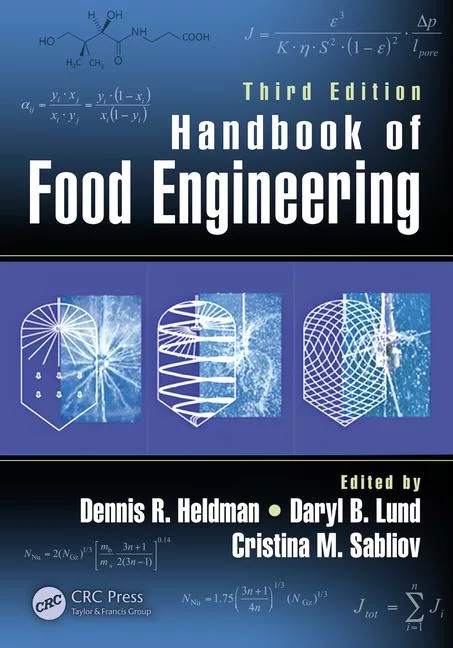Efficient transport, precise delivery
Increasing complexity
Consumers drive food producers to deliver lower cost, better taste, higher nutrition, more convenience and improved food safety. Processors, in turn, drive conveyor and other system suppliers to provide innovations that enable them to do these things. As consumer pressures continue to increase, so does production technology. For instance, as faster and hotter ovens and fryers come on stream, conveyor belts have to keep pace. Belts are now engineered to withstand higher temperatures and faster speeds. And a modern food plant has an impressive inventory of belts geared not only to each individual production line, but to each part of the plant.
Basically, there are four types of conveyor belts for food production—steel, modular plastic, fabric and composite. Steel is noted for its strength, temperature resistance and washdown performance. Modular plastic is highly sanitary and very flexible. Fabric and woven polymer substrates are very fast. And composites—woven substrates with a non-stick or other coating—are noted for their excellent release properties.
Friction and positive drive
Conveyor belts are either friction driven with tensioned rollers at both ends or positive driven with sprockets powered by servo-motors. Friction-driven belts are known for their high speed. Positive-driven belts are known for accuracy and tracking. Regardless of type, all belts must feature utmost hygiene, longevity, speed, strength, heat resistance, heat conductivity, the right release properties and a host of other benefits for the different types of foods traveling on them.
“There are literally hundreds of styles and configurations available today,” notes Tom Richardson, former president of NIBA (The Belting Association) and president of Conveyor Accessories Inc., Burr Ridge, IL. “Raw meat, for instance, has migrated through many phases—from fabric, rubber and synthetics to flat steel and molded plastic modular belts that can be easily steam cleaned between shifts,” he explains. Meanwhile, raw vegetables use modular plastic as well as composite belts. The latter are also used in the confections industry, with top surfaces selected for their specific release properties.
“An example is hot chocolate kisses coming off an extruder and onto a belt that has to cool them in less than a second and prevent them from sticking,” explains Richardson. The base of the belt is typically made from polyurethane or PVC, but the top surface may be one of several different types of Teflon or other similar materials carefully matched to temperature, product viscosity and other factors.
Specialization vs. multiple choice
Some companies that supply conveyor belting specialize in one area only, while others cover up to all four. Those with one type of belt claim they’re the best in that area because that’s all they do. Those that provide multiple solutions say they can meet customer requirements more effectively by not being bound to a single product offering.
Brett Friesen, president of Friesen’s Inc. of Detroit Lakes, MI, says his company is an example of the latter. “We don’t manufacture. We integrate—the belt, transport frame and controls—to make each installation a working system, which reduces cost of ownership and increases efficiency of both the individual transport conveyor and the total system to the end-user,” he notes. “We bring in hundreds of different belts, modify some of them and provide our customers with the solutions they need.
“We’re among a small group of integrators that uses 3-D computer modeling to design a holistic solution—conveyor belts and transport frames working as one,” Friesen says. When working with clients, he involves select people from around the world to study every inch of a new line on a 3-D computer program before specifying the final equipment design.
According to Friesen, hygiene, speed and maintenance are key considerations when choosing belting. Hygiene relates to easy and effective washdowns, as well as to how the belts, connectors and frames are designed to release food and other particles and how exposed they are to water and cleaning agents. “As for speed, we used to be looking at systems requiring 50 to 100 pieces per minute. Now it’s in the 100 to 300 range for the same products. Before, we were dealing with 3,000 to 7,000 pounds per hour of raw product. Now were up to 25,000 pounds per hour. We’ve gone from the race track to the Daytona 500, and customers still expect to run 24/7 without breakdowns.”
The trend is toward less maintenance staff, says Friesen. Maintenance workers are either unavailable due to a shortage, or budgets are no longer able to support them to the same degree. Freisen’s philosophy is to provide systems that are nearly maintenance free, so staff can be assigned to higher, more complex work inside the plant.
Ashworth Brothers Inc. of Winchester, VA manufactures both steel and modular plastic belting. “All belts have a specific purpose. However, in the food industry, metal and plastic belts dominate,” says Ashworth Chief Engineer Jonathan Lasecki. One of the belts the company is known for is its CB5 Baking Band, which first came out in the early 1960s and has since undergone significant development. It’s a dense, woven, stainless steel belt that provides even heating for uniform heat transfer. It features a distinctive V-pattern design that is able to grip liquid dough products firmly and transfer an aesthetic V-pattern design to the product’s bottom surface. It provides straight running, with less than 1/4-in. waver at the edges.
The company’s Omni-Pro stainless steel spiral belts incorporate a patented button-less weld that joins the ends of each rod to its links and is easier to clean than traditional welds. Meanwhile, the company’s modular plastic Advantage spiral line is the industry’s only plastic spiral belt that is NSF certified and USDA accepted for meat and poultry. “This makes the USDA inspector’s job easier and gives our customers a good night’s sleep,” says Lasecki.
Ashworth’s Advantage series also offers the ease of maintenance provided by modular plastic—belt pieces can be removed and replaced in minutes using only a screwdriver—with the strength provided by stainless steel instead of plastic connecting rods. Case in point: A major East Coast bread baker was having difficulty with a competitor’s modular all-plastic spiral belt. It was sagging in the middle and, after only four years, was becoming brittle and started breaking, resulting in excessive downtime. The bakery replaced it with an Ashworth Advantage 200 belt. Its steel rods eliminated the sagging problem and greatly reduced the wear or “cam-shafting” associated with plastic rods.
Eco thinking
Rich Grantham, food segment manager at Forbo Siegling of Huntersville, NC, says his company has a well-developed application as opposed to commodity-oriented approach in fabric and plastic. The company’s Transilon line consists of a polyester fabric base with a variety of thermoplastic or PVC food contact surfaces. Siegling also manufactures a line of ProLink plastic modular belting that combines HACCP-compatible materials, an ultra-smooth surface finish, advanced sprocket and connecting rod configuration, and open-hinge design that makes cleaning easy and effective.
“Our fabric belts are popular in the bakery industry,” notes Grantham, “and our high-release coverings will continue to evolve as the demand for gluten-free products, with extremely sticky doughs, continues to increase.”
Grantham recalls a frozen dough customer that was spending tens of thousands per year using flour as a release agent for sticky dough recipes, and more on continuous maintenance required for belt cleaning. Forbo Siegling installed one of its high-release fabric belts and was able to eliminate the flour duster.
Forbo Siegling has an environmental stewardship commitment that includes minimizing its carbon footprint, water usage and landfill. “On the landfill side, we have an option called EcoBelting, which is a service that we can offer to our customers to send used belts to an energy-from-waste facility to create electricity. After the belt has been used as an energy source, any residual ash is incorporated into cement used primarily in construction projects. As far as we know, it’s presently the only landfill avoidance option of its kind available for end-of-life belting,” says Grantham.
Strengths of steel
Rodrigo Sagastegui is the marketing specialist at Sandvik Processing Systems in Totowa, NJ. This Swedish group has been supplying solid and perforated steel belts worldwide to food processing and other industries for more than 100 years. “One of our strengths is the wide variety of steel grades we can offer to our customers,” says Sagastegui. “We have application-specific steel grades that ensure our customers meet their quality standards as well as their productivity goals.” Belt thickness can range from 0.3 to 3.5mm (0.012 to 0.138 in.) and widths from 50cm to 8.2 meters (1.6 to 26 ft.). Open-length, prepared and/or scribed or endless steel belts are available.
Up-front, steel belts may cost more than those made of other materials, but they can be more economical in the long term, according to Sagastegui. “Steel belts last many years and require only small amounts of water and detergents to clean. After a few years, our steel belts become one of the most cost-effective choices.”
Steel is definitely a big plus when it comes to hygiene. “We sell thousands of meters of steel belt to tomato producers in Italy,” says Sagastegui. “There, our biggest advantage is tolerance to acids. When you put tomatoes on plastic, you may start getting stains, which later could develop bacteria and contamination. Talking about meat, you have to be very careful about E. coli. No other material can compare to steel in regard to ease and thoroughness of cleaning.”
The company’s perforated steel belts enable hot air to be in contact with all parts of the product on them for effective drying. Five standard perforation patterns cover most requirements. A broad range of other patterns, with a minimum hole diameter of 0.8mm (0.03 in.) in different space configurations, can also be provided to suit specific applications.
Al Wosky, president of Belt Technologies in Agawam, MA, points out that stainless belts, because they’re seamless and have no moving joints, don’t require lubricants. “The material, in our case, is an average .1 or .25mm thick and is very flexible—only five times thicker than tin foil.”
This means the belt can wrap easily around small pulleys. Belt Technologies uses a patented, very smooth sprocket drive system that reduces wear. Steel belts don’t stretch, meaning they retain their accuracy over the life of the belt. “If a belt stretches, the product may end up in a position it’s not supposed to be in, which can create problems with a bar code printer or shrink-wrapper,” says Wosky. “Steel is strong and precise.”
With metal belts, sanitizing to meet FDA or USDA requirements can be accomplished using cold or heated high-pressure wash, chemical sprays or steam pressure. The flat, high-impact resistant surface is inert, does not absorb bacteria and releases microbes during the cleaning process.
Metal belts also have excellent heat transfer properties and are ideal for freezing, cooking, baking and processing seafood, meat, poultry, dairy (cheese) and snack foods. Attachments may be added for placement indexing and coatings for greater release properties.
Belt Technologies specializes in a variety of non-stick Teflon surfaces for its steel belts—PFE, PFA and FEPs. PFE coatings are suitable for higher temperature ranges, up to 660°F, whereas FEPs are good to 450°F or so, but their release properties are better. “Trade-offs exist between what different applications require,” says Wosky.
Much of the company’s focus is on packaging applications, including the new one-liter plastic/fiber Tetra Evero Aseptic container for UHT dairy products from Tetra Pak. Tetra Evero is Tetra Pak’s first hybrid aseptic carton bottle for milk (plastic top, fiber body), and the company’s first move from modular plastic belts to steel belts in production.
The Tetra Evero Aseptic systems uses a new gas phase sterilization technique that moves the preformed cartons through a unique aseptic chamber in pairs where they are exposed to hydrogen peroxide. The gas sterilizes the entire preformed package, inside and out. Steel instead of plastic belts are used to move the cartons through this part of the production process because of increased hygiene. .
One of the biggest manufacturers of steel belts in the world is Berndorf. Its US head office is in Elgin, IL. “Steel belts are ideal for baking, drying, freezing, cooling and steaming,” says Marketing Manager Daniela Weiszhar. “Our belts are produced to perform in an endless configuration between two drums, ensuring longer belt life and belt flatness. Our belts have dark, uniform surfaces for delivering even heat absorption and consistent product quality.” An example is the company’s CARBO 13 belt, which can handle operating temperatures up to 400°C.
“We also released the new Bernmatic BTRV Belt Tracking Roller, which offers precise tracking and monitoring. It’s easy to integrate into existing systems to increase belt performance, longevity and product quality.” An inductive sensor checks belt speed, and optical or mechanical sensors check the belt edge position.
Belt washing
Habasit America, headquartered in Suwanee, GA, is an international manufacturer of plastic modular and synthetic conveyor belting. One of the company’s most recent innovations is the HyClean Belt Washer, a CIP system for sprocket-driven belt systems. Recently, the company’s HyClean plastic modular M5060 and M5065 belts, sprockets and CIP system were awarded a Certificate of Compliance and Silver Award from EHEDG (European Hygienic Engineering & Design Group), an independent industry review body based in Europe.
The system features a patented sprocket design that allows 100 percent access to the hinge area. Mike Peach, the company’s director of business development, says it also reduces cleaning solution and water use. “Water reduction is something the entire food industry is focused on. Every effort to reduce its use has an effect on the bottom line and the environment.” From a performance perspective, the new CIP system, with its precise built-in nozzles, also brings a level of repeatability and cleaning efficiency not possible to achieve manually.
Metal detectors are common in all food plants, but they cannot identify non-metallic items. For this reason, X-ray detection is becoming more popular among food processors, notes Peach. “The initial investment is higher, but more companies, especially the larger ones, are installing them for added food safety, which is why we offer multiple products in X-ray detectable materials.”
Color is important as well. If a plant uses visual technology, it is important to have a color contrast between the product and the conveying surface. Blue belting is frequently used because there are no natural food products of that color.
Other major lines in the Habasit family include CleanLine, noted for its easy-clean and high release characteristics. Another, Cleandrive, combines fabric and plastic. The top surface is continuous, but the underside is sprocket driven. “It has been well received where there are particularly high sanitation requirements,” adds Peach. “Our fabric belts are also noted for their tight transfers over very small pulleys, or nosebars, from one belt to another. Cleandrive belts provide very gentle product movement, particularly for delicate bakery products.”
Fasteners
Companies that supply fasteners are another important part of the conveyor belt industry. Fasteners are made from stainless steel in numerous configurations and used as the main seam that joins the two ends of a continuous belt together. They are also used to perform patch splices when a belt fails, wears out or gets damaged.
“Most belts do not last to the end of their running life,” notes Flexco Market Development Manager Steven Courteau. “Many belts fail because of damage due to cuts, foreign material, failed bearings, food product getting under the belt and other things. Depending on the production environment, in some cases, we see belts being replaced every two weeks. In others, they last up to 20 years.”
In 2010, Flexco increased its focus on food when it purchased Novitool of the Netherlands. With it, the company acquired the Aero Splicing Press. It is fast, portable and air cooled, and all its components are integrated into a single unit (including controls). Competitive units have separate outboard control boxes connected to the press by wires, and are water-cooled, which is not ideal in a food production environment. “For food safety reasons, transporting water buckets for splicing presses is becoming increasingly prohibited,” says Courteau.
Tom Richardson at Conveyor Accessories points to his company’s Staplegrip stainless steel belt fastener system with the pneumatic Staple Gun SG-25XP as a good solution for replacing seams on fabric belts. “A rapid installation system is valuable to people when they need to take a belt apart, clean the seam and install a new one. The Staplegrip system is available in standard and custom widths ranging from 12 to 72 inches,” he says.
Conveyor belts are the highways inside a food production facility, providing efficient transport and delivery. While food and beverage manufacturers have done an impressive job in keeping up with changing demands from consumers and customers, so has the technology behind conveyor belting.
For more information:
Tom Richardson, Conveyor Accessories Inc., tr@conveyoraccessories.com
Brett Friesen, Friesen’s Inc., bfriesen@friesensinc.com
Jordan Bradford, Ashworth Brothers Inc., jbradford@ashworth.com
Rich Grantham, Forbo Siegling, rich.grantham@forbo.com
Rodrigo Sagastegui, Sandvik Processing Systems,
rodrigo.sagastegui@sandvik.com
Al Wosky, Belt Technologies, awosky@belttechnologies.com
Daniela Weiszhar, Berndorf, danielaw@berndorf-usa.com
Mike Peach, Habasit America, mike.peach@us.habasit.com
Steven Courteau, Flexco, scourteau@flexco.com
Looking for a reprint of this article?
From high-res PDFs to custom plaques, order your copy today!





